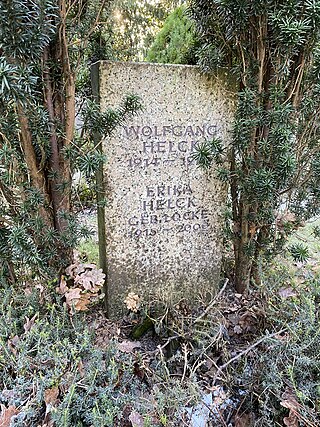
Florian Geyer von Giebelstadt was a German nobleman, diplomat, and knight. He became widely known for leading peasants during the German Peasants' War.

St. Johann is a municipality in the district of Reutlingen in Baden-Württemberg in Germany. The seat of the municipal administration is Würtingen. Large parts of the area (44.2%) of St. Johann are part of the UNESCO Biosphere Swabian Alb.
Jerg Ratgeb, also Jörg Ratgeb, was a German painter during the Renaissance, and a contemporary of Albrecht Dürer.

Eduard Heyck was a German cultural historian, editor, writer and poet.

Hans Wolfgang Helck was a German Egyptologist, considered one of the most important Egyptologists of the 20th century. From 1956 until his retirement in 1979 he was a professor at the University of Hamburg. He remained active after his retirement and together with Wolfhart Westendorf published the German Lexikon der Ägyptologie, completed in 1992. He published many books and articles on the history of Egyptian and Near Eastern culture. He was a member of the German Archaeological Institute and a corresponding member of the Göttingen Academy of Sciences.

Lorenz von Westenrieder was a well-known author and historian in Bavaria and a critic of the Elector Karl Theordor and supporter of Maximilian IV Joseph. There are several memorials to him in Munich.

The Baltringer Haufen was prominent among several armed groups of peasants and craftsmen during the German Peasants' War of 1524–1525. The name derived from the small Upper Swabian village of Baltringen, which lies approximately 25 kilometres (16 mi) south of Ulm in the district of Biberach, Germany. In the early modern period the term Haufe(n) denoted a lightly organised military formation particularly with regard to Landsknecht regiments.

Wilhelm Zimmermann was a German theologian and historian. Zimmermann has been described as a "founding father of German vegetarianism".
Carl Franz van der Velde was a German author of historical novels.
Christoph von Stadion (1478–1543) was Prince-Bishop of Augsburg from 1517 to 1543.

Michael Gaismair, was a leader of the German Peasants' War (1524-1525) in Tyrol and the Salzburg region.

Wilhelm Wiegand was a German archivist and historian. He is best known for his research of Alsatian history and his publications involving Frederick the Great.

Ferdinand Geminian Wanker was a German Roman Catholic moral theologian.

Karl Friedrich Wilhelm Rußwurm was a German-Estonian pedagogue, ethnologist and historian.

Heinrich Schreiber was a German Catholic theologian and historian, known for his writings about the city of Freiburg.

Christoph Langenmantel or Christoph Langenmantel vom Sparren was a nobleman, Carmelite friar, canon of Freising and a supporter of Martin Luther.

The Battle of Wurzach, was a battle during the German Peasants' War that took place near Bad Wurzach in the present-day district of Ravensburg in Upper Swabia.
Georg Karl Brauer was a German chemist.
Friedrich Gustav Schilling was a German musicologist, editor and lexicographer.

Eduard Adolf Daelen was a German painter and writer. For some of his writings he used the pseudonyms Ursus teutonicus, Angelo Dämon, Edu Daelen-Bachem and Michel Bär. He became known above all for the first biography of Wilhelm Busch, which he wrote in 1886.















